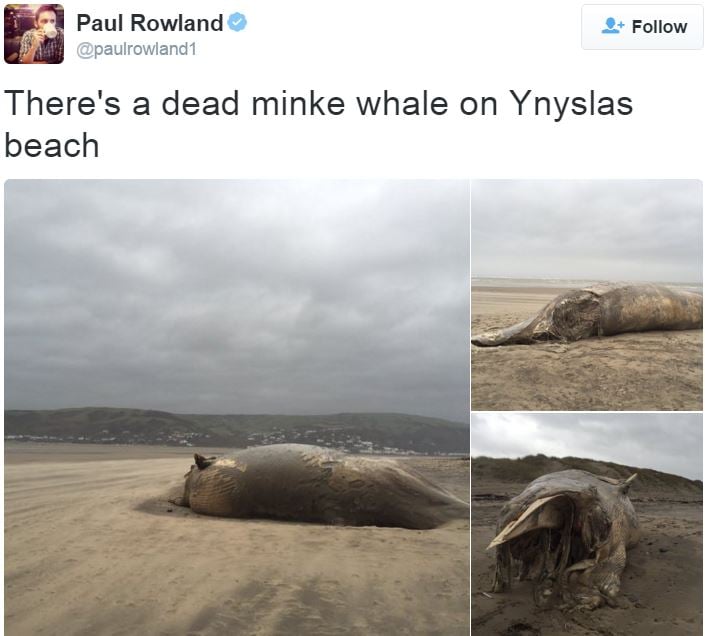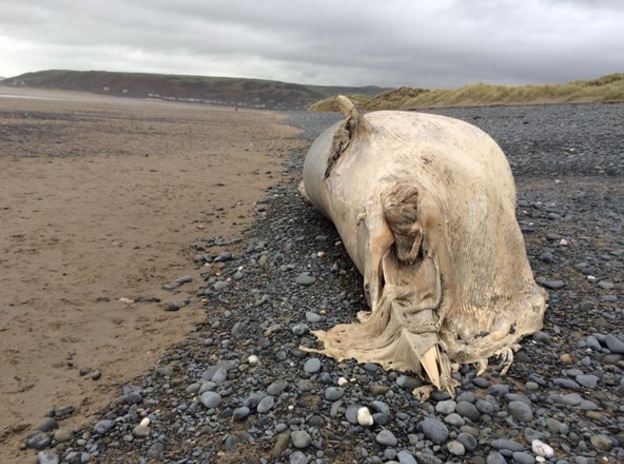People walking off their Christmas dinner were shocked to see a 15 foot dead whale washed up on the beach in Ynyslas, a small village in Wales about eight miles north of Aberystwyth on the west coast. It is believed to be a Minke whale, also known as lesser rorqual.
Minke whales are the second smallest baleen whale – only the pygmy right whale is smaller. Even so, males reach 23 feet and females 26 feet in length. If this one was just 15 feet, it was probably a juvenile.
Minke whales are part of the rorqual family of whale, which also includes the blue whale and humpback whale.
 Paul Rowland, editor of WalesOnline, took these picture of the washed up minke whale and posted them on Twitter. (Image: twitter.com/paulrowland1)
Paul Rowland, editor of WalesOnline, took these picture of the washed up minke whale and posted them on Twitter. (Image: twitter.com/paulrowland1)
A spokesperson for HM Coastguard told WalesOnline:
“We had reports about a whale washed up on shore on Christmas Day, however due to the bad weather we were unable to remove it. If the whale had been alive the situation might have been different, but as I understand it the carcass is pretty badly decomposed.”
“Someone will be going down to have a look at it today. They take samples for analysis, measure it and sometimes they would take away the lower jaw to perform a bit of an autopsy.”
The BBC quoted Walker Shirley Tunley as saying: “Over 40 years of Christmas morning visits by the Tunley family but this is a first.”
 Ali Chedgy was walking past and took this picture. (Image: twitter.com/wavesandwellies)
Ali Chedgy was walking past and took this picture. (Image: twitter.com/wavesandwellies)
About minke whales
Minkes can be found in many parts of the world. They are common around UK waters, and have been seen as far as the sea ice edges of the northern hemisphere and also in the tropics.
Minke whales are seasonal feeders. They sieve through the water with their baleen. They filter out small polar plankton, krill, and small fish, and even chase schools of cod, sardines, anchovies, capelin and herring.
According to uk.whales.org, whaling nations treat all minke whales as one species. But they are, in fact, at least two different species, which further divide into distinct biological populations.
 A mother minke whale with her calf. (Image: sdwhalewatch.com)
A mother minke whale with her calf. (Image: sdwhalewatch.com)
The two recognised species are the common minke and Antarctic minke. The dwarf minke, a subspecies, is similar in appearance to the common minke, but lives only in the Southern Hemisphere, and is slightly smaller.
Japan, Norway and Iceland target the minke whale for ‘scientific’ or commercial whaling.
They can remain underwater for as long as twenty minutes. They will swim beside a boat for some distance and are often seen at the surface feeding below flocks of seabirds.
According to the conservation society Sea Shepherd:
“Minke whales are the most abundant baleen whale. It is estimated that there are about almost 800,000 Minke whales worldwide.”
Video – Meet the Minke Whales

